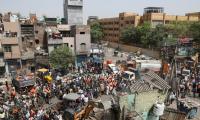When the US had lifted sanctions on Iran as a result of the Iran nuclear deal of 2015, the Rouhani-led government in Tehran optimistically expedited its efforts to fully operationalise the Chabahar Port in the near future.
Since the Trump administration has now completely withdrawn the US from the nuclear deal, the future of the Chabahar Port seems to be in limbo. The reinstatement of crippling financial sanctions on Iran’s economy could deal a critical blow to ongoing construction work and the future effectiveness of the port.
More littoral countries in Asia have lately increased their efforts to build seaports so as to yield rich economic dividends from regional trade. Since China and India are the main economic powers in the region, both countries have been deeply engaged in providing massive loans and cutting-edge technical assistance to some states in South Asia and the Persian Gulf to build seaports.
India has immensely invested in the Chabahar Port and a string of connectivity projects that link energy-rich Iran to war-torn Afghanistan. As a result, US sanctions on Iran will have a direct impact on India’s economic interests and hegemonic aspirations in the region.
The Chabahar Port is of considerable importance because of its close proximity to the Strait of Hormuz – the energy corridor in the Persian Gulf. Since the maximum capacity of the port is between 10 million tonnes and 12 million tonnes per annum, it has the potential to immeasurably help Iran revive its sanctions-hit economy. Despite these advantages, the future of the Chabahar Port is largely shrouded in uncertainty owing to America’s bellicose attitude towards Iran’s assertiveness in the Middle East and the growing Indo-Israeli bonhomie.
India’s aspiration of becoming a regional hegemon and countering China’s economic boom in Asia has compelled New Delhi to partner with Tehran in constructing and maintaining the Chabahar Port. Despite its domestic economic adversities, India has been technically and financially engaged with the Chabahar Port since 2003.
Although India is inclined towards creating a safer and less expensive trade route to Afghanistan and Central Asia via the Chabahar Port, New Delhi also wishes to use the same port to overshadow the importance of the Gwadar Port and militarily encircle Pakistan in the future. Pakistan should be fully alive to this mercantilist Indian policy to employ economic resources to build the most potent armed forces in the region.
As per an accord signed between India and Iran in May 2016, India is responsible for upgrading and operating two berths in the first phase of the Chabahar Port, with an investment of $85 million. The Modi government dispatched the first shipment of 15,000 tonnes of wheat to Afghanistan through Chabahar in October 2017. Both Iran and India have planned to make the port effectively operational by the end of this year.
But America’s decision to withdraw from the Iran nuclear deal and the deepening Indo-Israeli partnership could shatter India’s dreams of economically dominating South and Central Asia. Both Israel and the US are likely try to persuade or pressurise India into decreasing its engagement with the Iranian government.
As far as the future of the Chabahar Port is concerned, Iran may now face one of the worst financial crises in its history. Even though the nuclear deal allowed Iran to access about $100 billion in frozen assets, this has proved largely inadequate to revivify the faltering Iranian economy.
America’s withdrawal from the deal has plunged the Iranian rial to a record low against the dollar. The US dollar is being offered for as much as IRR 75,000 as compared to about IRR 65,000 before Trump withdrew from the deal. Iran’s currency is expected to further undergo devaluation when US sanctions start affecting the Iranian economy after 180 days.
Since the US is not a signatory to the deal now, it will impose obstructive restrictions on the purchase of US dollars by Iran and global trade in Iranian gold, coal, steel and cars. The Chabahar project is likely to be adversely impacted by US sanctions on Iranian shipping, port operators and central bank dealings.
This has led many analysts to wonder if India will be economically and diplomatically able to invest more in the Chabahar Port, given Iran’s financial inability to bear the costs. It goes without saying that New Delhi doesn’t have a fast-growing and satisfactory economic structure to financially support Iran in the wake of crushing sanctions.
India has sought funding from Japan for the 508-kilometre-long Mumbai-Ahmedabad High-Speed Rail Project and $35 billion more for some infrastructural projects. How can India invest considerable capital in the port and connectivity projects in Iran and Afghanistan when it has sought external technical and financial assistance to build its roads and railway lines?
Since the US continues to stay indefinitely in Afghanistan to contain China and push back Russia, Uncle Sam will never let Iran capitalise on the Afghan route to connect with the Central Asian Republics. Washington is fully aware that trading with the Central Asian countries will immensely help Tehran amass substantial revenue. The Pentagon knows that such trade will embolden Iran to increase its spending on the clandestine nuclear programme and advanced ballistic missiles, and increase its military footprints in Syria, Iraq, Lebanon and Yemen. But India has been largely unmindful of the fact that the US will never permit New Delhi to connect the Central Asian Republics to Iran via Afghanistan.
America’s decision to opt out of the deal may lead to friction and further widen the divergences between moderate and conservative factions in Tehran. Some powerful Iranian hardliners had been vehemently opposing the nuclear deal and had warned their government that the US would renege on its promises. The Trump administration has now proved that these concerns were valid.
Moreover, the projected inflation and unemployment in Iran are likely to compel a large number of Iranians to take to the streets against the government – as they did in December last year. Such demonstrations may create political instability in the country. Israel, Saudi Arabia and the US will presumably try to fish in the troubled waters by extending support to the protesting people. Under such circumstances, the government of Iran will not be able to direct its full attention on the timely construction of the Chabahar Port.
Trump is overwhelmed by some anti-Iranian hawks, such as National Security Adviser John Bolton and US Secretary of State Mike Pompeo. These hawks have advocated a disruptive regime-change or a short war against Iran. As a superpower, the US has so far preferred the option of waging wars against enemy states to topple established governments and plant its own handpicked political setups – as seen in Iraq and Afghanistan.
The recent thaw in relations between North Korea and the US, and America’s withdrawal from the nuclear deal are seen by some to indicate that Washington has made up its mind for a possible confrontation with Iran. Israel has full US support to target the Iranian forces stationed in war-ravaged Syria. Any escalation of the limited confrontation between Israel and Iran in Syria could take the war to Iran.
Israel, Saudi Arabia and the US could ostensibly carry out a limited war against Iran if they get the chance to do so. The Rouhani-led government is alive to such a threatening escalation between Israeli and Iranian forces in Syria. This sense of insecurity will make Tehran spend much of its time and meagre resources in bracing itself militarily for any untoward situation.
Although the brewing situation in the Middle East will make Iran further drift towards China and Russia, it will not guarantee the effectiveness of the Chabahar Port and Iran’s security. The feasibility of the Chabahar Port now hinges on Iran’s peaceful regional posture and astute Indian diplomacy.
The writer is an independentresearcher.
Email: ayazahmed6666@gmail.com
Twitter: @ayazahmed66665
This demand has fueled rapid growth deposit base of Islamic Banks and Islamic Windows operated by conventional banks
But Punjab Agriculture Food and Drug Authority building near Thokar Niazbeg on Multan Road stands out
Macron has been particularly vocal in their criticism, asserting that withholding arms from Kyiv plays directly into...
As PPP governs province, Bilawal Bhutto Zardari holds strategic position to address both violence and its underlying...
Critics argue that strategy is vague, but closer look indicates strategic alignment with global trends and national...
To defeat it, we must distrust bot-driven narratives, to defeat it, we must verify sources before believing or sharing







